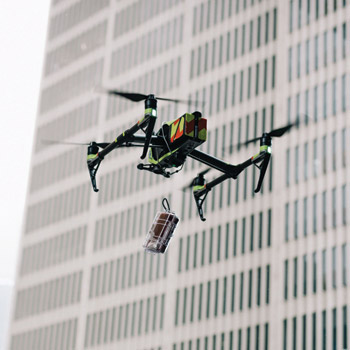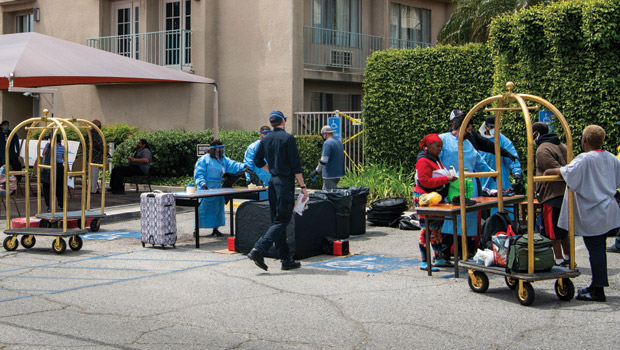Could drone deliveries help reverse opioid overdoses?
An epiphany led a medical student to consider whether drones could deliver naloxone to the scene of an overdose so a bystander could deliver the drug, even before emergency crews arrive.
During an opioid overdose, every minute that passes could mean life or death. While naloxone (Narcan) is effective at reversing overdoses, waiting for emergency responders to arrive and administer it takes precious time.
“The faster that you get the Narcan on board, the better chances you have. And despite the fact that there are Narcan distribution programs, etc., those who need it most generally don't have it,” said ACP Medical Student Member Matthew Tukel, a fourth-year medical student at Wayne State University School of Medicine in Detroit.

He recently studied whether drones carrying naloxone could potentially be used to help solve this problem in places with high rates of overdoses. Mr. Tukel and his brother Connor Tukel, a third-year medical student at Icahn School of Medicine at Mount Sinai in New York City, developed and tested a drone prototype in Detroit. Robert Weinbaum, a graduate student in physics at the University of Chicago, was responsible for the study design and statistical analyses.
Mr. Tukel's research abstract won first place among medical students at the ACP Michigan Chapter's Annual Scientific Meeting in October 2019, and the results were published online on June 30 by The BMJ Innovations. Mr. Tukel spoke with ACP Internist about the study and how the drone program might work in a real-world setting.
Q: What led you to come up with this idea?
A: I attend Wayne State University School of Medicine through their eight-year BS/MD program, and I'd simultaneously been working with drone technology for personal hobby. … I started a drone-based organization for students at Wayne State that exposed them to drones, how they worked, and the industrial applications, and then we actually built them ourselves with the help of a local partner that works in drone technology.
I had simultaneously been working in the emergency department, and … time after time, I would see opioid overdose patients who unfortunately expired. Looking into it a bit further, we found that in many cases, these people didn't make it just because emergency responders weren't able to get to them fast enough or Narcan wasn't able to be administered fast enough. It was for a variety of reasons. Detroit's a fairly big city with a pretty high opioid and medical burden, so emergency resources are spread thin here. And also geographic barriers: Getting to people sometimes can take quite a while, and in opioid overdose situations, seconds literally can be the difference between life or death.
I had this “aha!” moment. I was like, “What if we could use drones not to replace an ambulance, but just to bring the Narcan to the scene faster and potentially empower a bystander to intervene before that first responder arrives?”
Q: How does it work?
A: Over the course of a year, we built out an emergency response drone. We basically took the best platform that's available to consumers, and we completely rebuilt it for the purposes of delivering Narcan. We designed it to look like an [air] ambulance. We worked with a company in Slovenia that manufactured these payload hooks so that we could actually attach a shockproof container to the drone and drop the Narcan. … We were able to build out this whole project for under $3,000, which is pretty lean for the kind of technology we were using. And once we got that done, we figured, “Now we actually have to test this,” because the thing is, it's a pretty radical solution to the problem, and there's no objective data that says a drone is faster than a traditional first responder or an ambulance.
Q: How did you test the drone?
A: We linked up with the guy who controls EMS response in the city of Detroit, and they were able to get us a pretty large data set of Detroit-based first response runs to the scenes of actual or suspected opioid overdoses. So we looked through that data set, and we figured out what the most common distances were that first responders in Detroit had to travel to get to the scene of an opioid overdose.
And then, over the course of probably three to four months, we conducted speed trials using our drone and those common distances. … We would basically race this thing back and forth and back and forth, and we conducted a total number of 50 trials. … For the sake of adhering to FAA [Federal Aviation Administration] regulations, all the tests that were included in our research that were submitted for publication were manned [remote-controlled] trials because the FAA says that all commercial flights need to occur as manned flights. But we simultaneously recorded autonomous flights too because the way we visualize this would work in a real commercial scenario is autonomous flights, and this platform we built is capable of autonomous flights. We produced the exact same data with no pilot, meaning that the drone flew itself.
Q: What were the results?
A: We found with 95% certainty that we were able to arrive at the scene faster than traditional first responders, on the order of one to two minutes faster at those common distances that we tested. … The drone is able to fly over traffic, take direct routes. You're also flying 200 or 300 feet above the ground. A common problem that we heard about with Detroit first responders is that they're oftentimes not able to locate patients because somebody will call in and they're not where they said they are. So that ends up contributing to the delay as well.
We built this thing up, we conducted those speed trials, and we did it all in adherence with current FAA regulations. And we produced objective data saying that a drone can in fact travel faster than that traditional first responder, which opens up not only the conversation, but also sets the stage for future testing, which is obviously very necessary before this is rolled out commercially. But it's definitely the big first step that we needed to take to prove that this may, in fact, be a viable solution.
Q: How would this work in a real-world setting?
A: The way that emergency response works here specifically for opioid overdose (and I'm assuming everywhere else too) is somebody will overdose, and the literature says that in greater than 70% of situations, there's a bystander there because when people use, they generally don't use alone. So the bystander would call in to 911 dispatch, 911 would then dispatch an ambulance to them, and that's where we would get into the process. They would dispatch an ambulance, but they would simultaneously dispatch a drone. Again, since these are autonomous vehicles, we theoretically would dock them on top of buildings in very high-frequency overdose areas.
That's the thing that makes it more exciting. The mentor we were working with at Wayne State School of Medicine has collected data, and they filled out these maps of where overdoses are occurring in the city of Detroit with the highest frequency. … Our data proves that we can get a mile in just a minute or two, so if we dock these things close to the areas where they are occurring most, we would definitely be able to get there and drop the Narcan prior to the first responder and start the process. Once we are able to locate the patient, locate the scene, the drone arrives and the bystander ideally is still on the phone with dispatch, and they tell them to look overhead, the drone is going to arrive, and the Narcan's going to drop. And then they instruct the bystander on how to administer the intranasal spray, which we think is relatively doable.
Q: What are the challenges to getting this off the ground?
A: No. 1 is what I call a disruptive barrier. It's a radical new technology, kind of sounds crazy, and we really needed to give people a way to visualize the way it would work. So the way we addressed that [in promotional materials] is through our use of graphics explaining how it would work and creating a video. … I would also say regulatory barriers. So technically, right now, commercial flights with drones are not yet legal. It's something that's coming very soon, but it's technically still not legal yet. So we have to work within the confines of current FAA guidelines, which are somewhat limited for this sort of testing.
Q: What are your next steps?
A: Since technically it's not legal to carry out those commercial operations [with autonomous drones] just yet, we're using this time to focus on making sure our product and our solution is 100% sound and will work when it does become legal. We have the baseline data validating the concept, but there are a lot of additional tests that need to be carried out to figure out practical considerations of drone flight. I would say the first thing we have to do is behavioral testing: dropping the Narcan to a layperson and then having a simulated dispatcher instruct them through the administration of the Narcan and see if they'll be able to do it or not.
Also, as we think about the commercial rollout, we are now working within engineering at our university and simulating fleet management. This is just a single drone, but we have to assume that once this is legal, we'll be operating within a network of drones that will be flying for various reasons: deliveries, regulatory inspections, things like that. So we're experimenting with modeling how our drone would operate within a fleet of drones and the prioritization of calls and still being able to adhere to FAA regulations and determining if we would still be able to reach the scene as fast as we predict with other drones flying around it.
Finally, all this was done using a commercially available drone, even though we rebuilt it, and the commercial solution would probably not be the exact same as our prototype. So we're also working to identify a strategic partner who could build a customized drone specifically for this solution that would be commercially viable.




